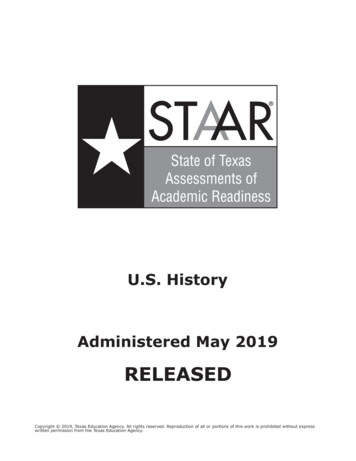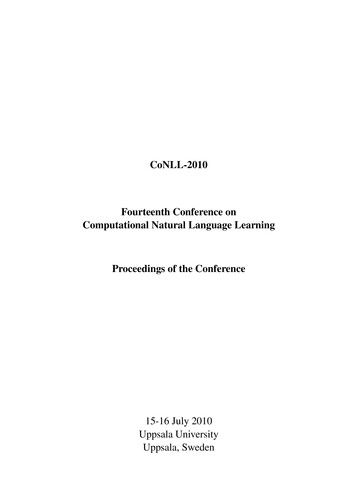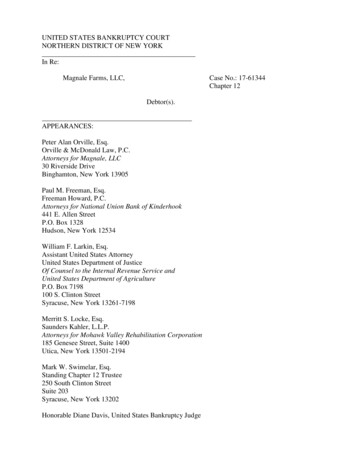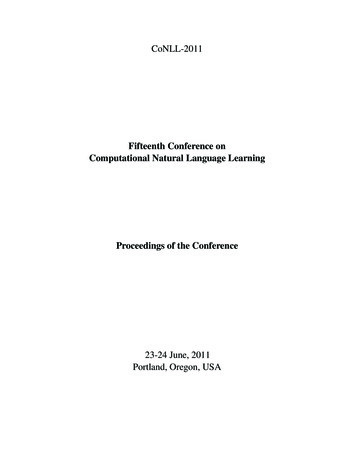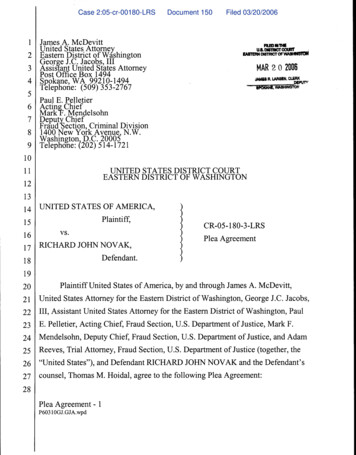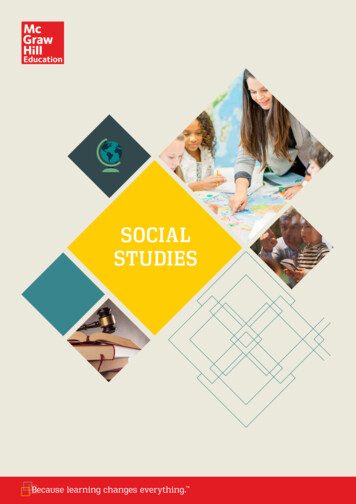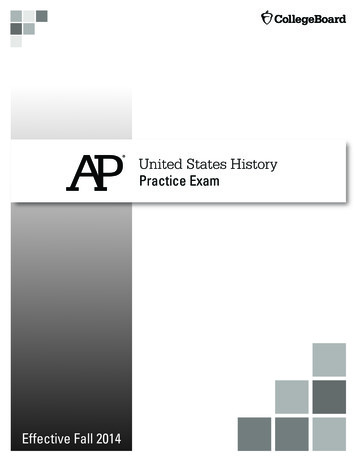
Transcription
United States HistoryPractice ExamEffective Fall 2014
Practice ExamExam Content and FormatThe 2015 AP U.S. History Exam is 3 hours and 15 minutes in length. There aretwo sections. Section I is 1 hour, 40 minutes and consists of 55 multiple-choice questionsaccounting for 40 percent of the final score and 4 short-answer questionsaccounting for 20 percent of the final score. Section II is 1 hour, 35 minutes and consists of 1 document-based questionand 2 long-essay questions. Students can choose which of the two long-essayquestions they respond to. It begins with a 15-minute reading period to readthe questions and plan your answers. The remaining 1 hour and 20 minutes isfor writing.Administering the Practice ExamThis section contains instructions for administering the AP U.S. History PracticeExam. You may wish to use these instructions to create an exam situation thatresembles an actual administration. If so, read the indented, boldface directionsto the students; all other instructions are for administering the exam and neednot be read aloud. Before beginning testing, have all exam materials ready fordistribution. These include test booklets and answer sheets.SECTION I, Part A: Multiple-Choice QuestionsWhen you are ready to begin Section I, Part A, say:Section I, Part A, is the multiple-choice portion of the exam. Mark allof your responses on your answer sheet, one response per question. Ifyou need to erase, do so carefully and completely. Your score on themultiple-choice section will be based solely on the number of questionsanswered correctly.You have 55 minutes for this part. Open your Section I bookletand begin.Note Start Time here . Note Stop Time here . Check that studentsare marking their answers in pencil on their answer sheets, and that they are notlooking at their Section II booklets. After 55 minutes, say:Stop working. I will now collect your multiple-choice answer sheet.SECTION I, Part B: Short-Answer QuestionsWhen you are ready to begin Section I, Part B, say:Section I, Part B is the short-answer portion of the exam. Write youranswers in the corresponding boxes on the free-response answer sheet.Use a pen with black or dark blue ink.You have 45 minutes for this part. Begin.U.S. History Practice Exam2
Note Start Time here . Note Stop Time here . Check that studentsare writing their answers in pen on their answer sheets, and that they are notlooking at their Section II booklets. After 45 minutes, say:Stop working. I will now collect your Section I booklet and your freeresponse answer sheet.There is a 10-minute break between Sections I and II. When all Section I materialshave been collected and accounted for and you are ready for the break, say:Please listen carefully to these instructions before we take a 10-minutebreak. Everything you placed under your chair at the beginning of theexam must stay there. Leave your Section II packet on your desk duringthe break. Are there any questions?You may begin your break. Testing will resume at .SECTION II: Free-Response QuestionsAfter the break, say:Section II begins with a 15-minute reading period. During the readingperiod, you will read the questions and plan your answers to thequestions. You may use any blank space of the page the questions ordocuments are printed on to organize your answers and for scratchwork, but you must write your answers on the lined pages provided foreach question. Answers must be written in ink. Are there any questions?You may now open the Section II booklet and begin the 15-minutereading period.Note Start Time here . Note Stop Time here . After 15 minutes, say:Stop. The reading period is over. You have 1 hour and 20 minutes leftto answer the questions. You are responsible for pacing yourself, andmay proceed freely from one question to the next. You will be promptedto move from the document-based question to the long essay after45 minutes to ensure that you have adequate time to complete the longessay. However, you may divide your time differently, using more or lesstime for each question. Write your answers on the lined pages providedfor each question. If you need more paper during the exam, raise yourhand. At the top of each extra piece of paper you use, be sure to writeyour name and the number of the question you are working on. Arethere any questions?. . .Begin Section II.Note Start Time here . Note Stop Time here . Check that studentsare using pens and that they are writing their answers in their exam booklets.After 45 minutes, say:You should begin working on Question 2 or Question 3. You will needthe remaining time to complete your last essay.3U.S. History Practice Exam
After 25 minutes, say:There are 10 minutes remaining.After 10 minutes, say:Stop working and close your exam booklet. Put your exam booklet onyour desk, face up. Remain in your seat, without talking, while the exammaterials are collected.If any students used extra paper for the free-response section, have thosestudents staple the extra sheet/s to the first page corresponding to that questionin their exam booklets. Collect a Section II booklet from each student andcheck that each student wrote answers on the lined pages corresponding to eachquestion. Then say:The exam is over. I will now collect your materials.U.S. History Practice Exam4
Name:AP U.S. HistoryAnswer Sheetfor Multiple-Choice 255326542755285AnswerU.S. History Practice ExamAnswer
AP United States History Exam SECTION I, Part A: Multiple ChoiceDO NOT OPEN THIS BOOKLET UNTIL YOU ARE TOLD TO DO SO.At a GlanceTime55 minutesNumber of Questions55Percent of Total Score40%Writing InstrumentPencil requiredInstructionsSection I, Part A of this exam contains 55 multiple-choice questions. Fill in only the circlesfor numbers 1 through 55 on your multiple-choice answer sheet. Because this sectionoffers only four answer options for each question, do not mark the (E) answer circle forany question.Indicate all of your answers to the multiple-choice questions on the multiple-choice answersheet. No credit will be given for anything written in this exam booklet, but you may usethe booklet for notes or scratch work. After you have decided which of the suggestedanswers is best, completely fill in the corresponding circle on the multiple-choice answersheet. Give only one answer to each question. If you change an answer, be sure that theprevious mark is erased completely. Here is a sample question and answer.Use your time effectively, working as quickly as you can without losing accuracy. Do notspend too much time on any one question. Go on to other questions and come back tothe ones you have not answered if you have time. It is not expected that everyone willknow the answers to all of the multiple-choice questions.Your total score on the multiple-choice section is based only on the number of questionsanswered correctly. Points are not deducted for incorrect answers or unansweredquestions.SECTION I, Part B: Short AnswerAt a GlanceTime45 minutesInstructionsSection I, Part B of this exam contains 4 short-answer questions. Write your responses inthe corresponding boxes on the free-response answer sheet.Number of Questions4Percent of Total Score20%Writing InstrumentPen with black or darkblue inkU.S. History Practice Exam6
The inclusion of source material in this exam is not intended asan endorsement by the College Board or ETS of the content, ideas,or values expressed in the material. The material has been selectedby the history faculty who serve on the AP United States HistoryDevelopment Committee. In their judgment, the material printed herereflects various aspects of the course of study on which this exam isbased and is therefore appropriate to use to measure the skills andknowledge of this course.7U.S. History Practice Exam
UNITED STATES HISTORYSECTION I, Part ATime—55 minutes55 QuestionsDirections: Each of the questions or incomplete statements below is followed by either four suggested answers orcompletions. Select the one that is best in each case and then fill in the appropriate letter in the corresponding spaceon the answer sheet.Questions 1 - 3 refer to the excerpt below.“In 1739 arrived among us from Ireland the Reverend Mr. [George] Whitefield, who had made himselfremarkable there as an itinerant preacher. He was at first permitted to preach in some of our churches; but theclergy, taking a dislike to him, soon refused him their pulpits, and he was obliged to preach in the fields. Themultitudes of all sects and denominations that attended his sermons were enormous. . . . It was wonderful tosee the change soon made in the manners of our inhabitants. From being thoughtless or indifferent aboutreligion, it seemed as if all the world were growing religious, so that one could not walk thro’ the town in anevening without hearing psalms sung in different families of every street.”Benjamin Franklin, The Autobiography of Benjamin Franklin1. Whitefield’s impact suggests that religiousculture among British North American colonistsin the 1700s was most directly shaped by(A) Roman Catholic influences(B) interest in commerce and business(C) trans-Atlantic exchanges(D) reliance on agriculture2. Whitefield’s open-air preaching contributedmost directly to which of the following trends?3. The preaching described in the excerpt is anexample of which of the followingdevelopments in the 1700s?(A) The development of an idea of republicanself-government(B) The emergence of calls for the abolition ofslavery(C) The increased influence of theEnlightenment(D) The expansion of Protestant evangelism(A) The growth of the ideology of republicanmotherhood(B) Greater independence and diversity ofthought(C) Movement of settlers to the backcountry(D) The pursuit of social reformGO ON TO THE NEXT PAGE.U.S. History Practice Exam8
Questions 4 - 7 refer to the graph below.United States Census Bureau4. Which of the following was a significant causeof the trend from 1843 to 1854 shown in thegraph?(A) Active encouragement of migration by theUnited States government(B) Economic hardships and politicalinstability in Europe(C) Incentives offered by United Statescompanies looking to hire skilledmigrants5. The migrants represented by the graph mosttypically settled in which of the followingregions of the United States?(A) The Northeast(B) The Southeast(C) The Southwest(D) The West Coast(D) Adoption of free trade policies byEuropean governmentsGO ON TO THE NEXT PAGE.9U.S. History Practice Exam
6. Which of the following was a direct effect of thetrend in immigration after 1845 shown on thegraph?(A) An increase in sectional tensions(B) A major economic downturn(C) An upsurge in nativist sentiment(D) The collapse of the second party system7. The main trend shown in the graph was mostdirectly associated with which of the followingprocesses occurring in the United States at thetime?(A) The convergence of European andAmerican cultures(B) The emergence of an industrializedeconomy(C) The displacement of American Indiansfrom the Southeast(D) The resurgence of evangelicalProtestantismGO ON TO THE NEXT PAGE.U.S. History Practice Exam10
Questions 8 - 10 refer to the excerpt below.“The history of mankind is a history of repeated injuries and usurpations on the part of man toward woman,having in direct object the establishment of an absolute tyranny over her. To prove this, let facts be submittedto a candid world.“He has never permitted her to exercise her inalienable right to the elective franchise.“He has compelled her to submit to laws, in the formation of which she had no voice. . . .“Having deprived her of this first right of a citizen, the elective franchise, thereby leaving her withoutrepresentation in the halls of legislation, he has oppressed her on all sides. . . .“He has taken from her all right in property, even to the wages she earns.”Seneca Falls Convention, Declaration of Sentiments and Resolutions, 18488. The ideas expressed in the excerpt most directlychallenged the prevailing ideal in the earlynineteenth century that(A) women should enjoy full and equal rightswith men(B) women should focus on the home and thedomestic sphere(C) the ability of women to earn wages was apositive development10. Many supporters of the declaration in 1848broke ranks with which of thefollowing groups by the 1870s?(A) Social Darwinists(B) Supporters of Southern secessionand states’ rights(C) Supporters of the Fifteenth Amendment(D) Isolationists(D) women should educate their children aboutthe rights and responsibilities ofcitizenship9. Which of the following developments in thesecond half of the nineteenth century bestrepresented the continuation of the ideasexpressed in the declaration?(A) A movement focused on women’s votingrights(B) Women’s support for the Social Gospel(C) Support for outlawing the production andsale of alcohol(D) A movement focused on religious revivalsand personal conversionGO ON TO THE NEXT PAGE.11U.S. History Practice Exam
Questions 11 - 13 refer to the excerpts below.“Wherefore, security being the true design and end of government, it unanswerably follows that whateverform thereof appears most likely to ensure it to us, with the least expense and greatest benefit, is preferable toall others. . . . Here too is the design and end of government, Freedom and Security.”Thomas Paine, Common Sense, 1776“[G]overnments are instituted among Men, deriving their just powers from the consent of the governed. Thatwhenever any Form of Government becomes destructive of these ends, it is the Right of the People to alter orto abolish it, and to institute new Government, laying its foundation on such principles and organizing itspowers in such form, as to them shall seem most likely to effect their Safety and Happiness.”Thomas Jefferson, Declaration of Independence, 177611. The excerpts were written in response to the(A) British government’s attempt to assertgreater control over the NorthAmerican colonies(B) British government’s failure to protectcolonists from attacks by AmericanIndians13. The principles expressed by Paine and Jeffersonbest account for which of the following featuresof the United States during and immediatelyafter the American Revolution?(A) The development of factions and nascentpolitical parties(B) The rapid expansion of frontier settlements(C) colonial governments’ failuresto implement mercantilist policies(C) The relatively limited powers of theArticles of Confederation(D) colonial governments’ attempts to extendpolitical rights to new groups(D) The growth of conflict between wealthyelites and poor farmers and laborers12. The ideas about government expressed by Paineand Jefferson are most consistent with which ofthe following?(A) The concept of hereditary rights andprivileges(B) The belief in Manifest Destiny(C) The principle of religious freedom(D) The ideas of the EnlightenmentGO ON TO THE NEXT PAGE.U.S. History Practice Exam12
Questions 14 - 17 refer to the excerpt below.“We conclude that in the field of public education the doctrine of ‘separate but equal’ has no place. Separateeducational facilities are inherently unequal.”Chief Justice Earl Warren, writing the unanimous opinion of the UnitedStates Supreme Court in Brown v. Board of Education of Topeka, 195414. Which of the following was the most immediateresult of the decision excerpted?(A) Radicals critiqued government actions asdoing too little to transform the racialstatus quo.(B) Education advocates raised awareness ofthe effect of poverty on students’opportunities.16. Which of the following sets of Supreme Courtdecisions demonstrated the strongest continuitywith the idea expressed in the excerpt?(A) Decisions endorsing the constitutionalityof the death penalty, such as Gregg v.Georgia(B) Decisions limiting affirmative actionprograms, such as Regents of theUniversity of California v. Bakke(C) Civil rights activists became increasinglydivided over tactical and philosophicalissues.(C) Decisions defining individual rights andprotections, such as Miranda v. Arizona(D) Segregationists in southern statestemporarily closed many public schoolsin an effort to resist the decision.(D) Decisions defining election laws, such asCitizens United v. Federal ElectionCommission15. The decision excerpted most directly reflected agrowing belief after the Second World War thatthe power of the federal government should beused to(A) promote greater racial justice(B) revitalize cities(C) foster economic opportunity(D) defend traditional visions of morality17. The Brown decision reversed which of thefollowing earlier decisions?(A) Marbury v. Madison, which established theprinciple of judicial review(B) Worcester v. Georgia, which establishedthat the federal government rather thanindividual states had authority inAmerican Indian affairs(C) Dred Scott v. Sandford, which proclaimedthat slaves could not be citizens(D) Plessy v. Ferguson, which endorsed racialsegregation lawsGO ON TO THE NEXT PAGE.13U.S. History Practice Exam
Questions 18 - 20 are based on the excerpt below.“The system of quotas . . . was the first major pillar of the Immigration Act of 1924. The second provided forthe exclusion of persons ineligible to citizenship. . . . Ineligibility to citizenship and exclusion applied to thepeoples of all the nations of East and South Asia. Nearly all Asians had already been excluded fromimmigration. . . . The exclusion of persons ineligible to citizenship in 1924 . . . completed Asiatic exclusion. . . Moreover, it codified the principle of racial exclusion into the main body of American immigration andnaturalization law.”Mae M. Ngai, historian, Impossible Subjects: Illegal Aliens and theMaking of Modern America, 200418. The Immigration Act of 1924 produced highlydiscriminatory results because it20. Which of the following evidence would bestsupport Ngai’s argument in the excerpt?(A) created a guest worker program thatencouraged temporary immigration butdenied citizenship(A) Census data showing the changingpercentages of the foreign-bornpopulation from 1920 to 1930(B) relied on a series of literacy tests andphysical examinations to manageimmigration(B) Narratives describing the challenges ofimmigrant family life in the 1920s(C) placed restrictions on immigration bynational origin, ethnicity, and race(C) Diplomatic correspondence reflecting theincreasing isolationism of United Statesforeign policy in the 1920s and 1930s(D) encouraged immigration of people withhighly sought after skills or family in theUnited States(D) Census data revealing the Great Migrationof African Americans to cities in theNorth and West in the 1920s19. The Immigration Act of 1924 most directlyreflected(A) cultural tensions between scientificmodernism and religiousfundamentalism in the 1920s(B) conflicts arising from the migration ofAfrican Americans to urban centers in theNorth(C) the emergence of an increasingly nationalculture in the 1920s shaped by art,cinema, and mass media(D) social tensions emerging from the FirstWorld WarGO ON TO THE NEXT PAGE.U.S. History Practice Exam14
Questions 21 - 23 refer to the excerpts below.“I believe that it must be the policy of the United States to support free peoples who are resistingattempted subjugation by armed minorities or by outside pressures. I believe we must assist free peoples towork out their own destinies in their own way. I believe that our help should be primarily through economicand financial aid which is essential to economic stability and orderly political processes.”President Harry Truman, address before a joint session of Congressarticulating what would become known as the Truman Doctrine, 1947“We welcome change and openness; for we believe that freedom and security go together, that the advance ofhuman liberty can only strengthen the cause of world peace. . . . General Secretary Gorbachev, if you seekpeace, if you seek prosperity for the Soviet Union and Eastern Europe, if you seek liberalization: Come hereto this gate! Mr. Gorbachev, open this gate! Mr. Gorbachev, Mr. Gorbachev, tear down this wall!”President Ronald Reagan, speech at the Brandenburg Gate in Berlin,Germany, 198721. The statements of both Truman and Reaganshare the same goal of(A) restraining communist military power andideological influence(B) creating alliances with recentlydecolonized nations23. Reagan’s speech best reflects which of thefollowing developments in United States foreignpolicy?(A) Caution resulting from earlier setbacks ininternational affairs(B) Increased assertiveness and bellicosity(C) reestablishing the principle of isolationism(C) The expansion of peacekeeping efforts(D) avoiding a military confrontation with theSoviet Union(D) The pursuit of free trade worldwide22. Truman issued the doctrine primarily in order to(A) support decolonization in Asia and Africa(B) support United States allies in LatinAmerica(C) protect United States interests in theMiddle East(D) bolster noncommunist nations, particularlyin EuropeGO ON TO THE NEXT PAGE.15U.S. History Practice Exam
Questions 24 - 26 refer to the late-nineteenth-century photograph below by journalist Jacob Riis. Bettmann/CORBISGO ON TO THE NEXT PAGE.U.S. History Practice Exam16
24. Conditions like those shown in the imagecontributed most directly to which of thefollowing?26. Advocates for individuals such as those shownin the image would have most likely agreed withwhich of the following perspectives?(A) The passage of laws restrictingimmigration to the United States(A) The Supreme Court’s decision in Plessy v.Ferguson was justified.(B) An increase in Progressive reform activity(B) Capitalism, free of government regulation,would improve social conditions.(C) A decline in efforts to Americanizeimmigrants(D) The weakening of labor unions such as theAmerican Federation of Labor(C) Both wealth and poverty are the productsof natural selection.(D) Government should act to eliminate theworst abuses of industrial society.25. The conditions shown in the image came aboutmost directly as a result of(A) low wages earned by workers in the latenineteenth century(B) the rise of the settlement house andPopulist movements(C) increased corruption in urban politics(D) the migration of African Americans to theNorth in the late nineteenth centuryGO ON TO THE NEXT PAGE.17U.S. History Practice Exam
Questions 27 - 29 refer the excerpt below.“Excepting only Yosemite, Hetch Hetchy is the most attractive and wonderful valley within the bounds of thegreat Yosemite National Park and the best of all the camp grounds. People are now flocking to it inever-increasing numbers for health and recreation of body and mind. Though the walls are less sublime inheight than those of Yosemite, its groves, gardens, and broad, spacious meadows are more beautiful andpicturesque. . . . Last year in October I visited the valley with Mr. William Keith, the artist. He wanderedabout from view to view, enchanted, made thirty-eight sketches, and enthusiastically declared that in variedpicturesque beauty Hetch Hetchy greatly surpassed Yosemite. It is one of God’s best gifts, and ought to befaithfully guarded.”John Muir, Century Magazine, 190927. Which of the following aspects of Muir’sdescription expresses a major change inAmericans’ views of the natural environment?(A) The idea that wilderness areas are worthysubjects for artistic works(B) The idea that wilderness areas serveas evidence of divine creation(C) The idea that government should preservewilderness areas in a natural state29. Muir’s position regarding wilderness was moststrongly opposed by which of the following?(A) Members of the Progressive movement(B) Urban political bosses(C) American Indians living on reservations(D) Companies involved in natural resourceextraction(D) The idea that mountainous scenery is morepicturesque and beautiful than flat terrain28. Muir’s ideas are most directly a reaction to the(A) increasing usage and exploitation ofwestern landscapes(B) increase in urban populations, includingimmigrant workers attracted by a growingindustrial economy(C) westward migration of groups seekingreligious refuge(D) opening of a new frontier in recentlyannexed territoryGO ON TO THE NEXT PAGE.U.S. History Practice Exam18
Questions 30 - 33 refer to the excerpt below.“[H]istory and experience prove that foreign influence is one of the most baneful foes of republicangovernment. . . . Excessive partiality for one foreign nation and excessive dislike of another cause thosewhom they actuate to see danger only on one side and serve to veil and even second the arts of influence onthe other. . . . The great rule of conduct for us, in regard to foreign nations, is in extending our commercialrelations to have with them as little political connection as possible. So far as we have already formedengagements, let them be fulfilled with perfect good faith. Here let us stop. Europe has a set of primaryinterests which to us have none, or a very remote relation. Hence she must be engaged in frequentcontroversies, the causes of which are essentially foreign to our concerns.”George Washington, Farewell Address, 179630. The concerns expressed by Washington were aresponse to the(A) debate over the proper treatment ofAmerican Indian tribes in thetrans-Appalachian West(B) dispute over the possibility of annexingCanada from Great Britain(C) controversy regarding support for therevolutionary government of France(D) conflict with Great Britain over thetreatment of American Loyalists31. The ideas expressed in Washington’s addressmost strongly influenced which United Statesforeign policy decision in the twentieth century?(A) The establishment of the United Nationsin 1945(B) The formation of the NATO alliancebetween the United States and WesternEurope in 1949(C) The refusal to join the League of Nationsin 191932. Which of the following groups most stronglyopposed Washington’s point of view in theaddress?(A) Democratic-Republicans(B) New England merchants(C) Southern plantation owners(D) Federalists33. Most historians would argue that therecommendations of Washington’s addressceased to have a significant influence on UnitedStates foreign policy as a result of(A) westward expansion in the nineteenthcentury(B) support for Cuban revolutionaries in theSpanish-American War(C) Woodrow Wilson’s support forinternational democratic principles duringthe First World War(D) involvement in the Second World War(D) The oil embargo against Japan in 1941GO ON TO THE NEXT PAGE.19U.S. History Practice Exam
Questions 34 - 36 refer to the excerpt below.“The colonizers brought along plants and animals new to the Americas, some by design and others byaccident. Determined to farm in a European manner, the colonists introduced their domesticatedlivestock—honeybees, pigs, horses, mules, sheep, and cattle—and their domesticated plants, including wheat,barley, rye, oats, grasses, and grapevines. But the colonists also inadvertently carried pathogens, weeds, andrats. . . . In sum, the remaking of the Americas was a team effort by a set of interdependent species led andpartially managed (but never fully controlled) by European people.”Alan Taylor, historian, American Colonies, 200134. The export of New World crops to the OldWorld transformed European society mostly by(A) improving diets and thereby stimulatingpopulation growth(B) encouraging enclosure of open lands andpushing workers off of farms(C) promoting greater exploration of theinterior of the American continents(D) fostering conflicts among major powersover access to new food supplies36. The trends described by Taylor most directlyillustrate which of the following major historicaldevelopments in the Atlantic world?(A) The growth of mercantile empires thatstretched across the Atlantic(B) The increasing anglicization of the Englishcolonies(C) The phenomenon known as the ColumbianExchange(D) The rise of the trans-Atlantic slave trade35. The patterns described in the excerpt mostdirectly foreshadowed which of the followingdevelopments?(A) The spread of maize cultivation northwardfrom present-day Mexico into theAmerican Southwest(B) The population decline in Native Americansocieties(C) The gradual shift of European economiesfrom feudalism to capitalism(D) The emergence of racially mixedpopulations in the AmericasGO ON TO THE NEXT PAGE.U.S. History Practice Exam20
Questions 37 - 39 refer to the map below.GO ON TO THE NEXT PAGE.21U.S. History Practice Exam
37. The pattern of colonial settlement up to 1700resulted most directly from which of thefollowing factors?(A) The large size of British colonialpopulations relative to American Indianpopulations39. The change in settlement patterns from 1700 to1775 best explains the(A) development of economic differencesbetween the northern and southerncolonies(B) British recognition of Native Americansovereignty(B) colonists’ difficulties in effectivelyresisting the British military during theAmerican Revolution(C) The orientation of the British coloniestoward producing commodities for exportto Europe(C) significant proportion of colonists whoremained loyal to Great Britain during theAmerican Revolution(D) British government attempts to imposegreater control over the colonies in thelate 1600s(D) growth of social tensions betweenbackcountry settlers and coastal elites38. The change in settlement patterns from 1700 to1775 had which of the following effects?(A) A decrease in the coastal population(B) An increase in conflicts between Britishsettlers and American Indians(C) A decrease in the economic importance ofslavery and other forms of coerced labor(D) An increase in trade with French CanadaGO ON TO THE NEXT PAGE.U.S. History Practice Exam22
Questions 40 - 42 refer to the excerpt below.“[T]he condition of the African race throughout all the States where the ancient relatio
Stop working. I will now collect your multiple-choice answer sheet. SECTION I, Part B: Short-Answer Questions. When you are ready to begin Section I, Part B, say: Section I, Part B is the short-answer portion of the exam. Write your . answers in the corresponding boxes on the free-response answ




